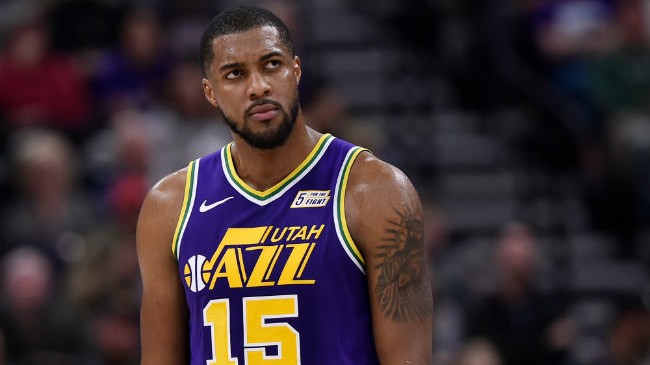
Derrick Favors came to Utah back in 2011 as the centerpiece of the Deron Williams trade alongside Devin Harris and the draft picks that ultimately became Enes Kanter and Trey Burke. That was seven years ago, and as the Jazz have undergone numerous roster reconstructions — from the Paul Millsap/Al Jefferson era, to Gordon Hayward/Rudy Gobert, and now Donovan Mitchell/Gobert — Favors is still around.
Now, Mitchell, Gobert, and to a lesser extent Joe Ingles form the core of the Jazz. Last season, lineups with Favors and any one of those three were excellent, but that hasn’t been the case thus far this year. The Favors/Ingles combination has a minus-6.8 differential (according to Cleaning the Glass) and Favors/Mitchell is minus-3.3. The Favors/Gobert pairing is plus-2.7, well below last year’s differential of plus-8.4.
Therein lies the problem for Favors: He hasn’t been good enough as a backup center to sustain Utah when Gobert is off the floor. The lineups without the reigning Defensive Player of the Year are both hemorrhaging points and not scoring. If Favors can’t play well without Gobert, he’d have to be dominant at power forward next to Gobert to justify his presence on Utah. However, the pairing of the two big men has not been strong enough to go up against the best teams in the Western Conference.
It’s hard to pinpoint exactly where Favors has fallen off this year. Utah itself has not been as good as expected, with Mitchell progressing more incrementally than hoped for and the defense taking a step back. The Jazz had aspirations of being the top challenger to Golden State in the West after a blistering finish to the regular season and a promising playoff showing despite missing Ricky Rubio for the conference semifinals. Instead, Utah is 7-6 and on the outside looking in of the postseason at this extremely early juncture.
From a distance, it looks like Favors is still as productive as he has been. He is scoring more efficiently than at any point in his career and is even dabbling with shooting the corner three, going 6-for-16 in twelve games.
Derrick Favors
Career high fg%
Career high efg%
Career high reb%
Career high oreb% by large margin
2nd best block rate
Career high percentage shots at the rim
Career high % of fga as dunks— David Locke (@DLocke09) November 14, 2018
And yet, his effect on the Jazz has been a negative. The offense is 14 points worse with Favors on the floor, and the defense is an additional six points worse. Regardless of his individual stat lines, the team cannot consistently score with Favors on the court. Favors collects a lot of offensive rebounds, but they don’t lead to good shots. On the other end, Jazz opponents are getting a high volume of corner threes and are shooting 61.6 percent at the rim against Favors. Only two other rotation players have even had a negative impact for Utah, Royce O’Neale and Georges Niang, and Favors plays as many minutes as the two combined.
At this point, there’s no sugar-coating it: The Utah Jazz in 2018-19 have been bad when Derrick Favors plays. Perhaps years of nagging injuries have reduced his athleticism to the point where he is no longer an effective defender. He has never really been a vertical threat, and making 0.5 threes per game doesn’t mean he adds floor spacing on offense.
The NBA has evolved in recent years so that players like Favors — big men without much range — have lost much of their value. Even so, Utah provided a stark rebuttal to that trend last year, proving that success was still possible with a dominant, if oversized, front court. Now, however, the rest of the league has seemingly caught on to the Jazz, and Favors’ ability to impact a game is waning. If he continues to perform at this level, it’s hard to see how Favors, whose $16 million deal is not guaranteed next season, has much of a future in Utah.






